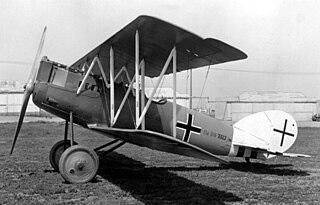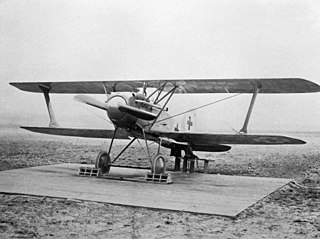Luft-Fahrzeug-Gesellschaft, also referred to as LFG, was a German aircraft manufacturer during World War I. They are best known for their various "Roland" designs, notably the Roland C.II Walfisch (whale), Roland D.II haifisch (Shark) and Roland D.VI, although they also produced a number of airships and many experimental designs.

The Pfalz D.XII was a German fighter aircraft built by Pfalz Flugzeugwerke. Designed by Rudolph Gehringer as a successor to the Pfalz D.III, the D.XII entered service in significant numbers near the end of the First World War. It was the last Pfalz aircraft to see widespread service. Though the D.XII was an effective fighter aircraft, it was overshadowed by the highly successful Fokker D.VII.

The Albatros D.X was a German prototype single-seat fighter biplane developed in 1918 in parallel with the Albatros D.IXme
The Benz Bz.IIIb was an eight-cylinder, water-cooled, V-engine developed in Germany for use in aircraft in 1918.

The DFW C.IV, DFW C.V, DFW C.VI, and DFW F37 were a family of German reconnaissance aircraft first used in 1916 in World War I. They were conventionally configured biplanes with unequal-span unstaggered wings and seating for the pilot and observer in tandem, open cockpits. Like the DFW C.II before them, these aircraft seated the gunner to the rear and armed him with a machine gun on a ring mount. Compared to preceding B- and C-class designs by DFW, however, the aerodynamics of the fuselage were more refined, and when coupled with more powerful engines, resulted in a machine with excellent performance.

The Roland D.VI was a German fighter aircraft built at the end of World War I. It lost a fly-off to the Fokker D.VII, but production went ahead anyway as insurance against problems with the Fokker.

The LFG Roland D.III was a fighter aircraft produced in Germany during World War I.

The Aviatik D.III was a German prototype single-seater fighter plane from the First World War, designed by Aviatik. It became the basis for the Aviatik D.IV and Aviatik D.V. In November 1917, the plane was first flown, using a 195 hp Benz Bz IIIbo gearless engine. It was of similar design to the Aviatik D.II, and was armed with two LMG 08/15 machine guns. After several tests at Adlershof from February 9–12, 1918, the plane underwent modifications, as requested by the Idflieg. In April, a second prototype, powered by a Benz Bz IIIbm, although several D.III powered by the original IIIbo engine were already under production; however, none of them were ever completed.

The Siemens-Schuckert D.VI was a single engine, single seat, parasol wing German fighter aircraft flown in 1919.

The Pfalz D.XV was a German single seat fighter aircraft which was approved for production right at the end of World War I, too late to enter service.
The Pfalz D.VII was a German biplane fighter aircraft from World War I. It was not put into production.
The Pfalz D.VI was a German sesquiplane fighter aircraft from World War I. It was not put into production.

The LFG Roland D.IV, later redesignated LFG Roland Dr.I was a German single engine, single seat triplane fighter flown in mid-1917. It produced no performance or operational advantages over existing types and only one was built.

The LFG Roland D.IX was a World War I German single seat fighter aircraft, a biplane powered by one of a new generation of powerful rotary engines. Three slightly different prototypes were built but there was no series production.

The LFG Roland D.XV was a World War I German single seat fighter aircraft, ordered as a test-bed for engine comparisons. It was distinguished from earlier Roland biplane designs by the elimination of flying wires. Two later aircraft, also called LFG Roland D.XV, were completely different designs with slab sided fuselages.

The LFG Roland D.XVI, initially designated the LFG Roland E.I, was a single-seat, single-engine, parasol wing German fighter aircraft flown close to the end of World War I. Only two were built.

The LFG Roland D.XVII was a single-seat, single-engine, parasol wing German fighter aircraft flown close to the end of World War I. Only one was built.

The Aviatik D.VII was a prototype German single-seat biplane fighter aircraft built by Aviatik in the last year of the First World War. It could not participate in the Third Fighter Competition of October 1918 because it used the wrong engine and it saw no military service, although 50 aircraft were found in storage after the war. The only real major change from the earlier Aviatik D.VI was a completely new tail structure.

The Aviatik D.VI was a German prototype single-seater fighter aircraft of the First World War, designed by Aviatik.

The LFG V 3 Susanna was a three seat, high wing monoplane flying boat with a single, pusher configuration engine mounted above the wing. A later variant, the LFG V 3a Susanne, was a bigger, more powerful four-seater. Only one of each was built.
















